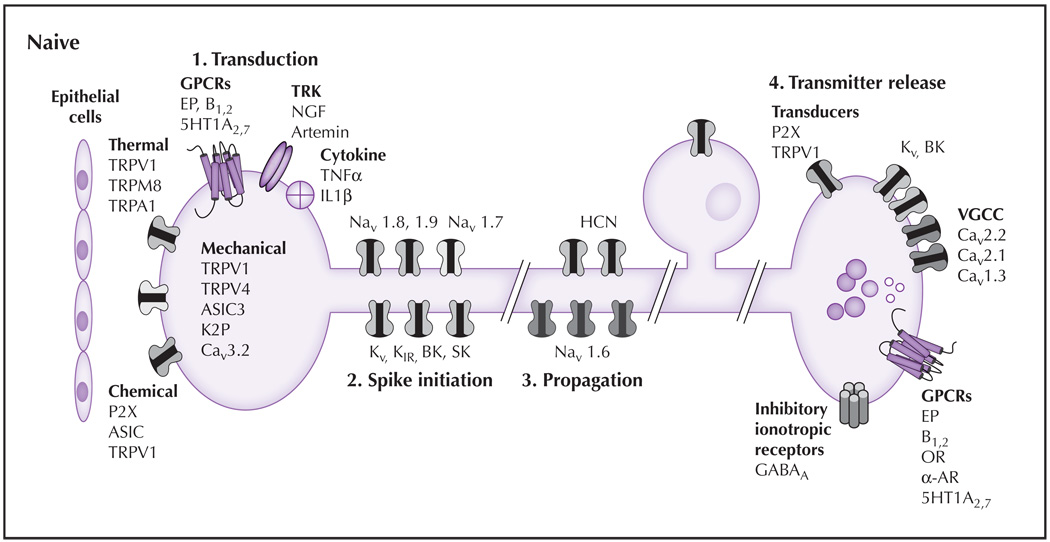Figure 1.
The principal sensory functions of nociceptive afferents consist of transduction, spike initiation, propagation, and transmitter release. (1) Transduction: In naive tissue, proteins thought to play a role in mechanotransduction include TRPV4, ASIC-3, and Cav3.2. Several different classes of TRP channels are involved in transduction of temperature from noxious cold (TRPA1), cool (TRPM8), warm (TRPV4), and hot (TRPV1). Ionotropic chemoreceptors present in nociceptive afferents include TRPV1, ASIC3, and P2X3. A wide variety of metabotropic receptors also are present on the terminals of nociceptive afferents including GPCRs, which are responsive to prostaglandins (EP, bradykinin, 5HT), TRK, and receptors for cytokines. (2) Spike initiation: Action potential threshold is regulated by several K+ channels (eg, Kv, KIR, K2P, BK, SK). HCN channels also contribute to action potential threshold. Nav1.9 also may contribute to establishing action potential threshold. The channels responsible for the upstroke of the action potential include Nav1.7 and Nav1.8. (3) Spike propagation: The ion channels underlying action potential propagation are distinct from those underlying spike initiation and include Nav1.6. HCN channels also contribute to spike propagation. (4) Transmitter release: The release of transmitter at the central terminals of nociceptive afferents is dependent on VGCCs, which are modulated following activation of inhibitory GPCRs and serve as the primary mechanism for the therapeutic efficacy of OR and α-AR agonists. Transmitters present in nociceptive afferents are generally packaged in small clear vesicles (which generally contain the excitatory amino acid glutamate) and large dense core vesicles (which contain, among other things, neuropeptides [eg, substance P, calcitonin generelated peptide]). A number of excitatory transducers (eg, P2X3 and TRPV1) appear to facilitate central transmitter release. Inhibition of the central terminal may involve activation of Kv, BK channels, and presynaptic GABAA receptors. Excitatory GPCRs (eg, EP, B1,2 receptors) also are present. 5HT—serotonin; AR—adrenergic receptor; ASIC—acid-sensing ion channel; B—bradykinin; BK—large conductance Ca2+ dependent channel; GABA—γ-aminobutyric acid; GPCR—G protein–coupled receptor; HCN—hyperpolarization-activated cyclic nucleotide channel; IL—interleukin; NGF—nerve growth factor; OR—opioid receptor; SK—small conductance Ca2+ dependent channel; TNF—tumor necrosis factor; TRK—tyrosine receptor kinases; TRPA—transient receptor potential ankyrin; TRPM—transient receptor potential melastatin; TRPV—transient receptor potential vanilloid; VGCC—voltage-dependent Ca2+ channel.

